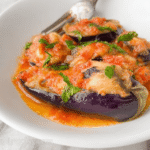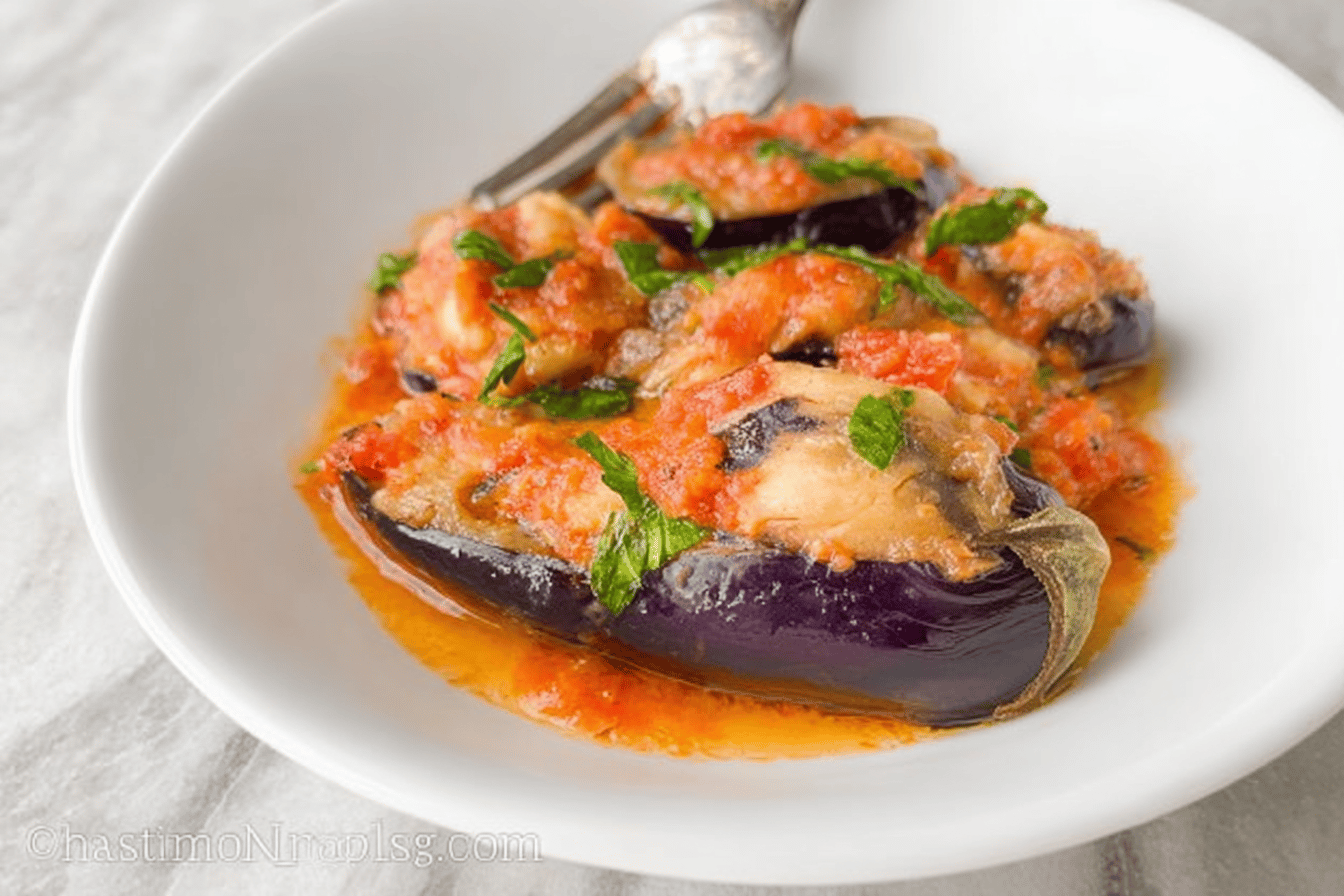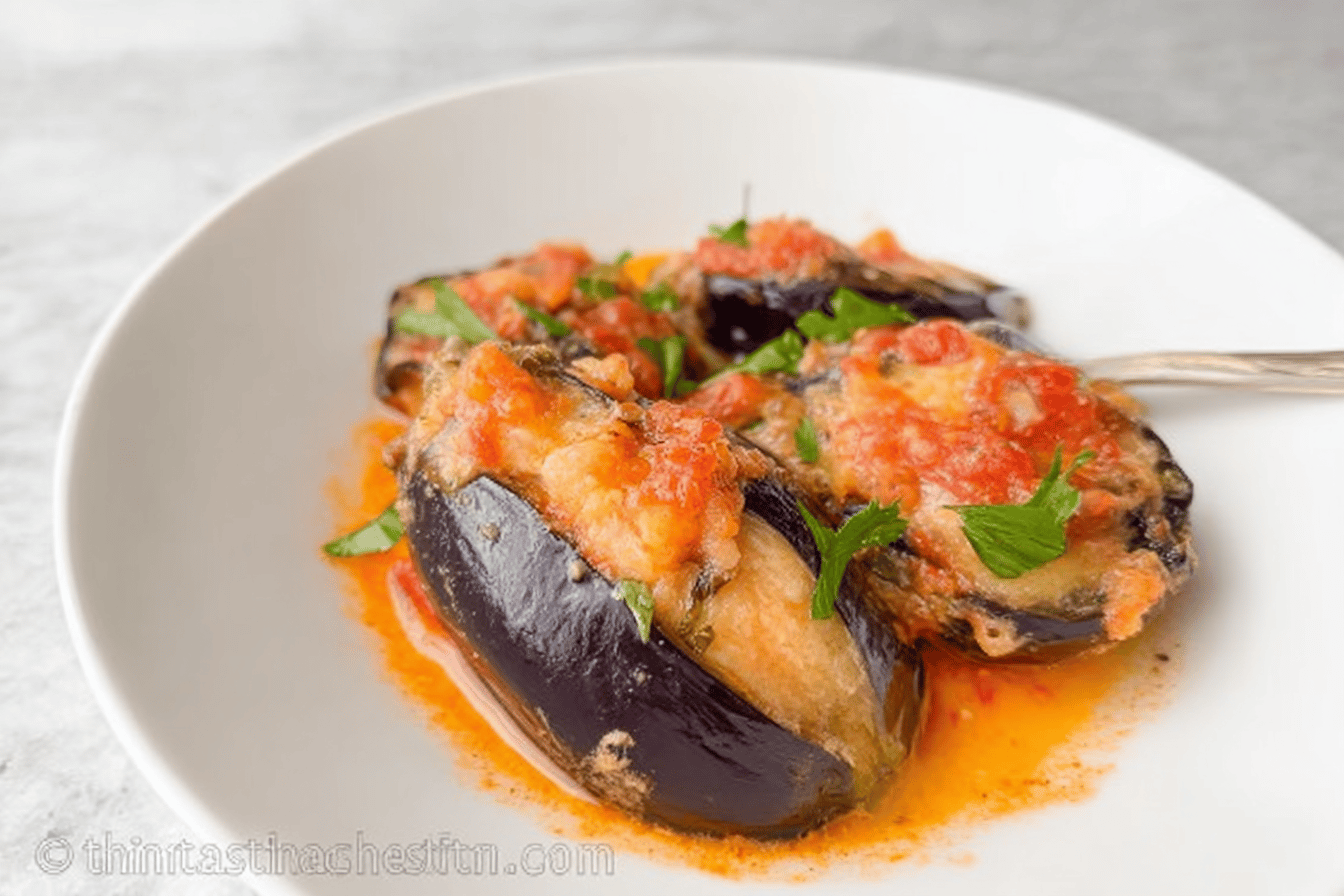Why You’ll Love This Eggplant
Eggplant, known scientifically as part of the nightshade family, offers a versatile addition to meals with its edible fruit used widely in global cuisines. The fruit features a spongy texture that absorbs flavors well and comes in various forms, such as purple, white, or green varieties, making it appealing for diverse recipes. This eggplant-based dish stands out for its simplicity in preparation, requiring only basic ingredients and quick steps suitable for everyday cooking.
Health benefits are a major draw, as eggplant provides essential nutrients like fiber, vitamins, and antioxidants that support digestion and heart health. Its low-calorie profile, with about 25 kcal per 100 grams and high water content of around 92%, makes it ideal for those managing their weight. Additionally, the presence of antioxidants in the purple skin promotes overall wellness, aligning with needs of diet-conscious individuals like busy parents and students seeking nutritious options.
The dish’s adaptability allows for easy modifications to suit different dietary preferences, including vegan and gluten-free variations. Its distinctive flavor profile combines savory tastes from spices and herbs, enhanced by eggplant’s absorbent nature that soaks up oils like olive oil during cooking. This makes it perfect for home cooks, food enthusiasts, and even seniors looking for flavorful yet straightforward meals.
Beyond taste, eggplant’s global appeal stems from its cultivation worldwide, where it is grown for its oval, elongated, or slender shapes, often started from seeds indoors 8 to 10 weeks before the last frost to ensure healthy plants. Tips for best results, such as salting slices to reduce bitterness, enhance the cooking process while maintaining texture, especially when leaving the skin on for grilling or roasting. For those interested in more vegetable-based recipes, consider visiting our site for a zucchini pesto pasta guide that complements eggplant dishes.
Jump To
- 1. Why You’ll Love This Eggplant
- 2. Essential Ingredients for Eggplant
- 3. How to Prepare the Perfect Eggplant: Step-by-Step Guide
- 4. Dietary Substitutions to Customize Your Eggplant
- 5. Mastering Eggplant: Advanced Tips and Variations
- 6. How to Store Eggplant: Best Practices
- 7. FAQs: Frequently Asked Questions About Eggplant
- 8. Eggplant
Essential Ingredients for Eggplant
Eggplant serves as the foundation for many recipes, valued for its mild flavor and tender texture when prepared correctly. This section outlines the key components needed, drawing from common culinary practices that include salting to minimize bitterness and using oils for flavor enhancement. By listing ingredients precisely, readers can replicate the recipe with ease, incorporating standard items like salt and various flavorings for a well-rounded dish.
Main Ingredients
- 2 medium eggplants – provide the base with a tender texture and mild flavor
- 3 tablespoons olive oil – enhances flavor and aids in cooking
- 1 teaspoon garlic powder – adds aromatic depth
- 1/2 teaspoon smoked paprika – provides a subtle smoky flavor
- Salt and pepper to taste – seasoning for balance
Special Dietary Options
- Vegan: Use plant-based olive oil and avoid any dairy or animal-based additives
- Gluten-free: All ingredients are naturally gluten-free; ensure spices are certified gluten-free
- Low-calorie: Reduce olive oil amount or use cooking spray to lower fat content
Commonly, recipes also feature cooking oil or fat (typically 2 to 4 tablespoons), which helps eggplant absorb flavors, along with flavorings such as garlic, chili, soy sauce, tamarind, yogurt, tomatoes, onions, spices, and herbs adjusted for regional tastes. These elements ensure the dish remains comprehensive and adaptable for travelers or working professionals exploring new flavors.
How to Prepare the Perfect Eggplant: Step-by-Step Guide
Preparing eggplant involves straightforward steps to achieve optimal texture and flavor, starting with proper handling to remove the green calyx and reduce bitterness. Raw eggplant is often sliced to about 1 cm thick, sprinkled with 1 teaspoon of salt, and left for 20-30 minutes before rinsing and draining, a technique that draws out excess moisture. Various cooking methods such as steaming, stir-frying for about 10 minutes, roasting for 20-60 minutes, or even barbecuing highlight eggplant’s versatility in the kitchen.
First Step: Wash and pat dry the eggplants, then slice them into 1/2 inch thick rounds for even cooking, ensuring to remove the green calyx at the top for better results.
Second Step: Lightly salt the eggplant slices and let them sit for 20 minutes to draw out bitterness, a process that aligns with tips for preventing browning and maintaining freshness.
Third Step: Preheat the oven to 400°F (200°C) and arrange the eggplant slices on a baking sheet lined with parchment paper to promote even heat distribution.
Fourth Step: Brush each slice lightly with olive oil using 2-4 tablespoons for enhanced flavor absorption and sprinkle with garlic powder, smoked paprika, salt, and pepper for a balanced taste.
Fifth Step: Bake for 20-25 minutes, turning halfway through, until the eggplants are golden and tender, showcasing the absorbent flesh that makes cooked eggplant ideal for mashing into sauces or spreads.
Final Step: Serve warm as a side or base for various dishes, adapting by adding ingredients like tomatoes or herbs for nutritional variety. Due to eggplant’s edible skin and seeds, leaving it on during roasting helps maintain texture, as recommended for grilling or barbecuing.
| Cooking Method | Time Required | Benefits |
|---|---|---|
| Roasting | 20-60 minutes | Enhances flavor with caramelization |
| Stir-Frying | About 10 minutes | Quick and retains nutrients |
| Steaming | 10-15 minutes | Preserves vitamins and low in oil |
Dietary Substitutions to Customize Your Eggplant
Eggplant recipes can be tailored to individual needs, offering alternatives that maintain nutritional value while accommodating various preferences. For instance, eggplant’s low-calorie and high-fiber content makes it a great choice for diet-conscious individuals, and substitutions can incorporate other vegetables rich in vitamins like potassium and manganese. Common flavorings such as soy sauce or herbs provide flexibility for adapting to regional cuisines.
Protein and Main Component Alternatives
- Replace eggplant with zucchini or portobello mushrooms for varied textures and flavors, which also offer similar antioxidant properties.
- Use tofu or tempeh for additional plant-based protein suitable for vegan diets, enhancing the dish’s protein content to about 1% per serving.
Vegetable, Sauce, and Seasoning Modifications
- Substitute tomato sauce with a tahini-based dressing for a nutty flavor, which pairs well with eggplant’s absorbent texture.
- Swap smoked paprika for cumin or chili powder based on spice preference, allowing for adjustments in taste while keeping the recipe low in fat.
- Include seasonal vegetables like bell peppers or spinach to enhance nutrition and taste, adding vitamins C and K for better overall health.
These changes ensure the recipe remains accessible for newlyweds, baking enthusiasts, or busy parents, while eggplant’s properties, such as its 92% water content, help in creating light, flavorful meals.
Mastering Eggplant: Advanced Tips and Variations
Eggplant mastery involves techniques that optimize its spongy texture and flavor absorption, building on basic preparation methods like salting to reduce bitterness. With eggplant available in sizes from small to large and colors including yellow or reddish-purple, growers can start seeds indoors 8 to 10 weeks before the last frost for optimal spacing and pest reduction. Advanced approaches allow for creative variations, making it suitable for food enthusiasts and travelers seeking diverse tastes.
Pro Cooking Techniques
Score the eggplant skin before cooking to allow better flavor absorption, ensuring the skin, which contains antioxidants like anthocyanins, remains intact for texture.
Flavor Variations
- Experiment with Mediterranean herbs like oregano and basil for a fresh twist, or use Asian-inspired sauces such as soy or miso to incorporate global flavors.
- Adjust seasonings with chili or tamarind to match regional cuisines, enhancing the dish’s nutritional profile with added vitamins.
Presentation and Make-Ahead Options
Garnish with fresh parsley or toasted nuts to add color and texture, making it visually appealing for family meals.
Prepare and marinate eggplant slices in advance for convenience, then bake just before serving, ideal for working professionals.
Cooking eggplant promptly after cutting prevents browning, as its flesh reacts quickly to air, preserving both appearance and nutritional benefits like moderate potassium levels.
How to Store Eggplant: Best Practices
Proper storage of eggplant maintains its freshness, given its high water content of about 92% and sensitivity to ethylene from other fruits. Fresh eggplant should be stored at room temperature for 1-2 days or in the refrigerator for up to 5 days to avoid bruising, which can shorten its shelf life. These practices ensure the vegetable retains its antioxidants and vitamins for healthy meals.
- Refrigeration: Store cooked eggplant in an airtight container in the refrigerator for up to 3 days to maintain freshness and prevent spoilage.
- Freezing: Cool the eggplant completely before freezing in a sealed bag; it remains best for up to 2 months, retaining its fiber and low-calorie attributes.
- Reheating: Reheat gently in the oven or microwave to preserve texture and flavor without drying, keeping the dish nutritious.
- Meal Prep Considerations: Portion cooked eggplant into single servings to easily thaw and reheat for quick meals, supporting busy lifestyles.
For those growing eggplant, transplant outdoors after the frost risk passes with proper spacing to reduce pests, ensuring a steady supply for storage.

FAQs: Frequently Asked Questions About Eggplant
What are the health benefits of eating eggplant?
Eggplant is rich in fiber, vitamins, and antioxidants, which support heart health and digestion. It contains nasunin, a powerful antioxidant found in the skin that protects cells from damage. Additionally, eggplant provides vitamins such as B1, B6, and potassium, which help regulate blood pressure. Including eggplant in your diet can also aid in weight management due to its low calorie and high fiber content, promoting a feeling of fullness.
How do you properly cook eggplant to avoid bitterness?
To reduce bitterness, slice eggplant and sprinkle with salt, then let it sit for 20 to 30 minutes. This process draws out excess moisture and bitterness. Afterward, rinse the slices and pat them dry before cooking. Baking, grilling, roasting, or sautéing eggplant are popular methods, and using olive oil enhances its flavor and texture. Avoid overcooking to prevent sogginess.
Can you eat eggplant skin, and is it healthy?
Yes, eggplant skin is edible and contains many beneficial nutrients, including antioxidants and fiber. The skin’s purple pigment, nasunin, has been shown to protect brain cell membranes from damage. Keeping the skin on while cooking also helps the slices retain their shape. However, in some older or larger varieties, the skin can be tougher, so peeling might be preferred for texture.
How should you store fresh eggplant to keep it fresh longer?
Store eggplant at room temperature if you plan to use it within 1-2 days. For longer storage, place it in a perforated plastic bag in the refrigerator’s crisper drawer for up to 5 days. Avoid storing eggplant near ethylene-producing fruits like bananas or tomatoes, as this can cause rapid spoilage. Handle eggplant gently to prevent bruising, which shortens shelf life.
What are some easy and healthy eggplant recipes for beginners?
Simple recipes for beginners include roasted eggplant slices seasoned with olive oil, garlic, and herbs; baba ganoush, a smoky eggplant dip made by blending roasted eggplant with tahini and lemon juice; and eggplant stir-fry with soy sauce and vegetables. These dishes showcase eggplant’s flavor and require minimal preparation, making them ideal for quick, nutritious meals.

Eggplant
- Total Time: 45-105 minutes (varies with method)
- Yield: Varies by recipe
- Diet: Vegan, Gluten-Free
Description
🍆 Eggplant recipes offer a versatile, healthy ingredient that absorbs flavors beautifully, making each meal rich and satisfying.
🌿 Packed with antioxidants and low in calories, eggplant supports wellness while adding vibrant texture to your dishes.
Ingredients
– 2 medium eggplants provide the base with a tender texture and mild flavor
– 3 tablespoons olive oil enhances flavor and aids in cooking
– 1 teaspoon garlic powder adds aromatic depth
– 1/2 teaspoon smoked paprika provides a subtle smoky flavor
– Salt and pepper to taste seasoning for balance
Instructions
1-First Step: Wash and pat dry the eggplants, then slice them into 1/2 inch thick rounds for even cooking, ensuring to remove the green calyx at the top for better results.
2-Second Step: Lightly salt the eggplant slices and let them sit for 20 minutes to draw out bitterness, a process that aligns with tips for preventing browning and maintaining freshness.
3-Third Step: Preheat the oven to 400°F (200°C) and arrange the eggplant slices on a baking sheet lined with parchment paper to promote even heat distribution.
4-Fourth Step: Brush each slice lightly with olive oil using 2-4 tablespoons for enhanced flavor absorption and sprinkle with garlic powder, smoked paprika, salt, and pepper for a balanced taste.
5-Fifth Step: Bake for 20-25 minutes, turning halfway through, until the eggplants are golden and tender, showcasing the absorbent flesh that makes cooked eggplant ideal for mashing into sauces or spreads.
6-Final Step: Serve warm as a side or base for various dishes, adapting by adding ingredients like tomatoes or herbs for nutritional variety. Due to eggplant’s edible skin and seeds, leaving it on during roasting helps maintain texture, as recommended for grilling or barbecuing.
Notes
🌿 Salting eggplant slices before cooking reduces bitterness and excess moisture.
🍽 Cook eggplant promptly after cutting to prevent browning.
🔥 Leave the skin on when grilling or roasting to maintain texture; always remove the calyx prior.
🌱 When growing eggplant, start seeds indoors 8-10 weeks before last frost and transplant outdoors after frost risk passes.
🐞 Space plants properly to minimize pest issues.
- Prep Time: 15 minutes (plus soaking time)
- Soaking Time: 20-30 minutes
- Cook Time: 10-60 minutes (varies with method)
- Category: Vegetable, Main Dish, Side Dish
- Method: Salting, Frying, Roasting, Stewing, Grilling, Stir-Frying, Baking
- Cuisine: Global
Nutrition
- Serving Size: 1 cup cooked eggplant
- Calories: 25 kcal per 100g raw
- Carbohydrates: 6 g per 100g raw
- Protein: 1 g per 100g raw
- Cholesterol: 0 mg
Keywords: Eggplant Recipes,Healthy Meals,Flavorful Vegetable,Aubergine Cooking


